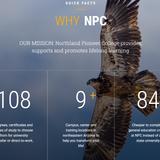- Coconino Community College is a public community college in Coconino County, Arizona. It enrolls more than 7,500 learners annually. The college offers more than 50 associate degrees and certificates. Scholarships are available through the CCC Foundation.
School Highlights
Coconino Community College serves 4,276 students (24% of students are full-time).
The college's student-teacher ratio of 21:1 is lower than the state community college average of 22:1.
Minority enrollment is 56% of the student body (majority American), which is less than the state average of 61%.
Quick Facts (2025-26)
- Enrollment: 4,276 students
- In-state tuition: $2,820
- Out-state tuition: $9,495
- Student-teacher ratio: 21:1
- Minority enrollment: 56%
- Source: Integrated Postsecondary Education Data System (IPEDS)
Top Rankings
Coconino Community College ranks among the top 20% of public schools in Arizona for:
Category
Attribute
Diversity
School Overview
The teacher population of 202 teachers has stayed relatively flat over five years.
Coconino Community College
(AZ) Community College Avg.
Carnegie Classification
Associate's Colleges: High Transfer-Mixed Traditional/Nontraditional
Baccalaureate/Associate's Colleges: Mixed Baccalaureate/Associate's
Institution Level
At least 2 but less than 4 years
At least 2 but less than 4 years
Institution Control
Public
Public
Total Faculty
202 staff
202 staff
School Calendar
Student Body
The student population of Coconino Community College has grown by 19% over five years.
The student-teacher ratio of 21:1 has increased from 16:1 over five years.
The Coconino Community College diversity score of 0.72 is more than the state average of 0.71. The school's diversity has stayed relatively flat over five years.
Total Enrollment
4,276 students
5,392 students
Student-Teacher Ratio
21:1
22:1
# Full-Time Students
1,025 students
1,208 students
# Part-Time Students
3,251 students
4,184 students
# Enrollment Undergraduate
427 students
339 students
# Full-Time Undergraduate Students
1,025 students
1,238 students
# Full-Time Graduate Students
n/a
66 students
# Part-Time Undergraduate Students
3,251 students
5,400 students
# Part-Time Graduate Students
n/a
11 students
Total Dormitory Capacity
n/a
250 students
% American Indian/Alaskan
22%
3%
% Asian
1%
4%
% Hispanic
18%
36%
% Black
2%
7%
% White
44%
39%
% Hawaiian
n/a
2%
% Two or more races
4%
4%
% Non Resident races
n/a
1%
% Unknown races
9%
4%
Diversity Score
0.72
0.71
College Completion Rate (Students who graduate in less than 4 years)
21%
49%
College Completion Rate (Students who graduate in 4 years or more than 4 years)
n/a
60%
Average Graduate Earnings (10 Years)
$32,100
$32,900
Tuition and Acceptance Rate
The public in-state tuition of $2,820 is less than the state average of $3,445. The in-state tuition has declined by 9% over four years.
The public out-state tuition of $9,495 is more than the state average of $8,201. The out-state tuition has stayed relatively flat over four years.
In-State Tuition Fees
$2,820
$3,445
Out-State Tuition Fees
$9,495
$8,201
Tuition Notes
$124.00 per credit hour (resident).
% Students Receiving Some Financial Aid
63%
82%
Median Debt for Graduates
$10,500
$9,500
Median Debt for Dropouts
$5,500
$4,750
Acceptance Rate
n/a
100%
Source: 2024 (or latest year available) Integrated Postsecondary Education Data System (IPEDS)
School Notes
- Sample of notable school alumni/alumnae:
- Joshua Singer, artist and Academy of Art University student. -
Frequently Asked Questions
How much does Coconino Community College cost?
Coconino Community College's tuition is approximately $2,820 for In-State students and $9,495 for Out-State students.
Who are famous alumni from Coconino Community College?
Coconino Community College famous alumni include: Joshua Singer, artist and Academy of Art University student..
What is Coconino Community College's ranking?
Coconino Community College ranks among the top 20% of community college in Arizona for: Diversity in US community colleges.
Recent Articles

Student Success Programs That Actually Work at Community Colleges
Discover evidence-based student success programs at community colleges for 2025, with outcomes, examples, and actionable strategies.

Best Community Colleges by Career Path in 2025
Explore top community colleges for career-training programs in 2025, including healthcare, IT, skilled trades and business pathways.

Dual Enrollment in High School: Benefits, Risks & Real Student Results
Explore the pros and cons of dual enrollment in high school, real outcomes for students in 2025, and how to decide if it’s right for you.










